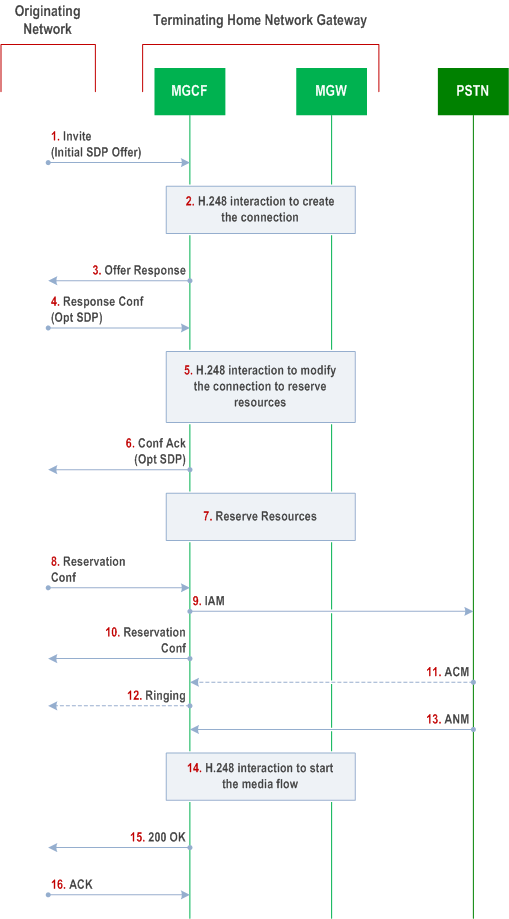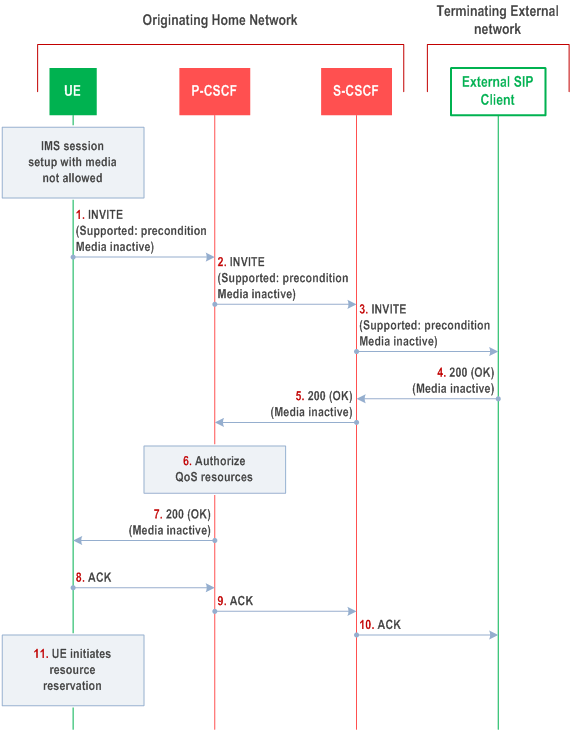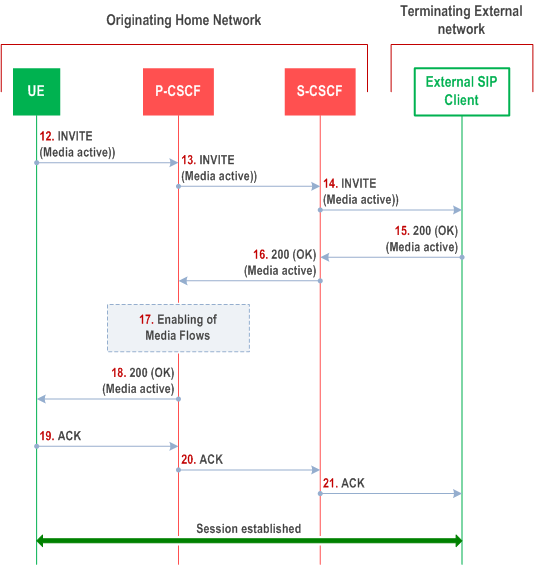Content for TS 23.228 Word version: 19.1.0
1…
3…
4…
4.2.4…
4.3…
4.4…
4.13…
4.16…
5…
5.2…
5.3…
5.4…
5.4.7…
5.4.8…
5.4a…
5.5…
5.5.3…
5.6…
5.6.3…
5.7…
5.7.3…
5.7.5…
5.7.8…
5.8…
5.10…
5.11…
5.11.3…
5.11.3.3
5.11.3.4
5.11.4…
5.11.5…
5.11.5.3…
5.11.6…
5.12…
5.16…
5.16.2…
5.19…
5.20…
A…
E…
E.2.2…
G…
G.5…
H
I…
J…
K…
L…
M…
M.3…
N…
P…
Q…
Q.2.5…
R…
S…
T…
U…
U.2…
V…
W…
X…
Y…
Z…
AA…
AA.3…
AB…
AC…
AC.7…
AC.7.2…
AC.7.2.2
AC.7.2.3…
AC.7.4…
AC.7.9…
AC.7.9.3…
AC.7.10…
AC.7.10.4.2…
AC.9…
AC.10…
AC.11…
AD…
AE…
AF…
AG…
5.7.3 (PSTN-T) PSTN termination p. 138
The MGCF in the IM CN subsystem is a SIP endpoint that initiates and receives requests on behalf of the PSTN and Media Gateway (MGW).Other nodes consider the signalling as if it came from a S-CSCF. The MGCF incorporates the network security functionality of the S-CSCF.
PSTN termination may be done in the same operator's network as the S-CSCF of the session originator. Therefore, the location of the MGCF/MGW are given only as "Terminating Network" rather than "Home Network" or "Visited Network".
Further, agreements between network operators may allow PSTN termination in a network other than the originator's visited network or home network. This may be done, for example, to avoid long distance or international tariffs.

The PSTN termination procedure is as follows:
Step 1.
MGCF receives an INVITE request, containing an initial SDP, through one of the origination procedures and via one of the inter-serving procedures.
Step 2.
MGCF initiates a H.248 interaction to pick an outgoing channel and determine media capabilities of the MGW.
Step 3.
MGCF determines the subset of the media flows proposed by the originating endpoint that it supports, and responds with an Offer Response message back to the originator. This response is sent via the S-S procedure.
Step 4.
The originating endpoint sends a Response Confirmation. The Response Confirmation may also contain SDP. This may be the same SDP as in the Offer Response sent in Step 3 or a subset. The originating UE is free to continue to offer new media on this operation or on subsequent exchanges using the Update method.
Step 5.
MGCF initiates a H.248 interaction to modify the connection established in step #2 and instruct MGW to reserve the resources necessary for the media streams.
Step 6.
MGCF responds to the offered media towards the originating party.
Step 7.
GW reserved the resources necessary for the media streams.
Step 8.
When the originating endpoint has completed its resource reservation, it sends the successful Resource Reservation message to MGCF, via the S-S procedures.
Step 9.
MGCF sends an IAM message to the PSTN.
Step 10.
MGCF sends response to the successful resource reservation towards originating end.
Step 11.
The PSTN establishes the path to the destination. It may optionally alert the destination user before completing the session. If so, it responds with an ACM message.
Step 12.
If the PSTN is alerting the destination user, MGCF indicates this to the originating party by a provisional response indicating Ringing. This message is sent via the S-S procedures.
Step 13.
When the destination party answers, the PSTN sends an ANM message to MGCF.
Step 14.
MGCF initiates a H.248 interaction to make the connection in the MGW bi-directional.
Step 15.
MGCF sends a SIP 200-OK final response along the signalling path back to the session originator.
Step 16.
The Originating party acknowledges the final response with a SIP ACK message.
5.7.4 (NI-T) Non-IMS Termination to an external SIP client |R6| p. 140
This sub clause describes the IMS session setup procedures towards external SIP clients that don't support the required IMS SIP extensions.
In this scenario, the UE originates an IMS session without requiring the support for precondition capabilities, towards an external SIP entity that does not support those capabilities. Since required resources are not yet available at the UE, all the media components are set to inactive. In this example the external SIP client does not support the Precondition extension of SIP so the related precondition information within SIP/SDP is ignored.
When both parties have agreed to the session and media parameters and the UE has established resources for the media, the UE initiates session modification setting the status of the media components to active and is thus enabling the media transfer to start. Figure 5.19b and Figure 5.19c together illustrate session flows for one possible originating session establishment towards a non-IMS client in an external network with QoS authorization and Policy and Charging Control support.
For illustration purposes these session flows show the case of a non-roaming origination. This flow is a variant of MO#2 defined in sub clause 5.6.2. The same principles apply in roaming cases, i.e. analogous variants of MO#1 defined in sub clause 5.6.1 are also supported for interworking with SIP clients that do not support the required IMS procedures.
(no figure)

The UE initiates an INVITE message, which indicates the support of the precondition capability Since required resources are not yet available, the UE sets all media components to inactive state, as shown in Figure 5.19b.
Step 1-3.
UE initiates a new IMS session indicating the support of the precondition capability and setting all media components to inactive state.
Step 4-5.
Acknowledgement of the session and media parameters are sent from the terminating side to the P-CSCF.
Step 6.
The P-CSCF may at this point instruct PCRF/PCF to authorize the resources being negotiated.
Step 7.
The acknowledgement of the session and media parameters forwarded towards the originating UE.
Step 8-10.
The session is established, but media transfer is not allowed yet.
Step 11.
Depending on the bearer establishment mode selected for the IP-CAN session, resource reservation shall be initiated either by the UE or by the IP-CAN itself. The UE starts the resource reservation for the media as shown in Figure 5.19b. Otherwise, the IP-CAN initiates the reservation of required resources after step 6.

Once the session parameters have been agreed and the UE has successfully reserved resources for the media components, the session set-up continues by setting the media components to active, as shown in session flow 5.19c.
Step 12-14.
At this point in time, the session is established between the two parties.
UE initiates activation of media by initiating an INVITE procedure towards the terminating party.
Step 15-16.
The terminating party accepts media activation, and corresponding signalling is passed back towards the originating party along the session path.
Step 17.
The P-CSCF receives the acceptance of media activation. At this point, the P-CSCF may instruct the PCRF/PCF to enable the media flows that have been authorized for the session.
Step 18.
The P-CSCF forwards the signalling message to the originating UE indicating that the session setup can continue and activation of media is performed.
Step 19-21.
The Session establishment is then acknowledged through the session path.